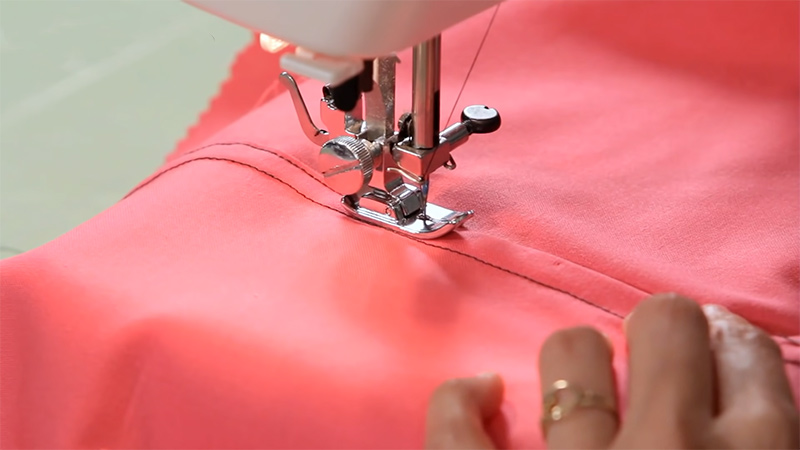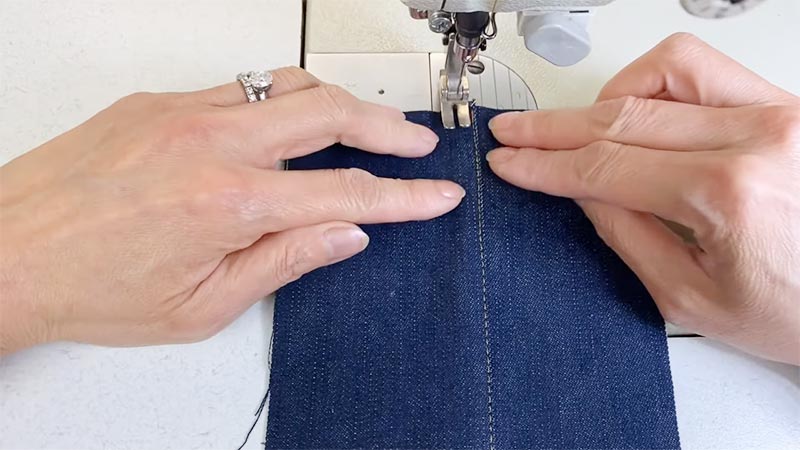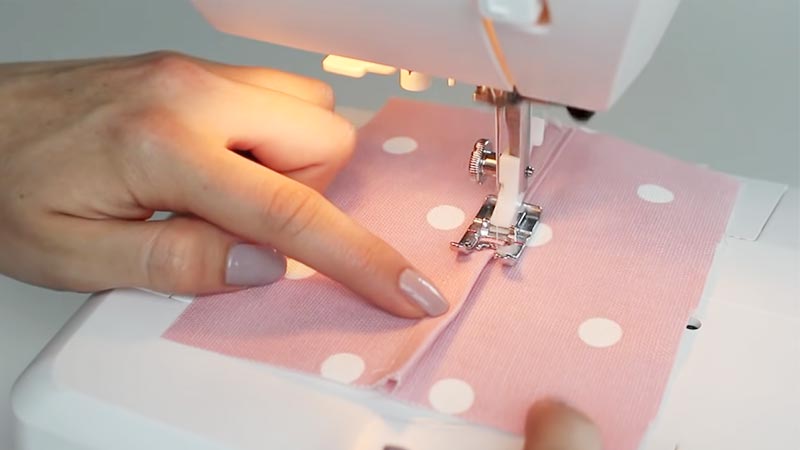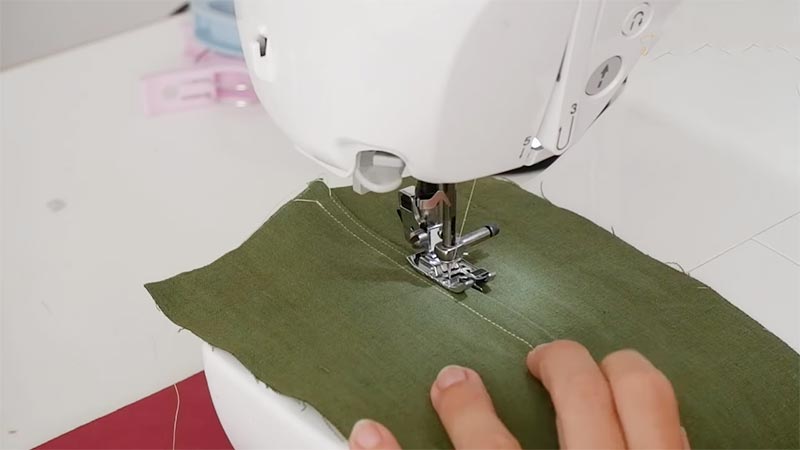Felling in sewing is a meticulous technique that transforms the ordinary into the exceptional. It is the art of crafting impeccably neat and robust seams by deftly folding one edge of fabric over another and stitching them together.
This method conceals unruly raw edges, effectively prevents fraying, and imparts a pristine, professional finish to the seam.
Felling is an essential skill in the seamstress’s toolkit, elevating sewing projects to new durability and aesthetic appeal levels.
From heavy-duty denim garments to delicate quilts, understanding the nuances of felling is the hallmark of a proficient sewer, ensuring that each creation boasts structural integrity and visual finesse.

What Is Felling In Sewing?
Felling in sewing is a technique used to create strong, neat, and durable seams by folding one edge of fabric over another and then stitching them together.
This method conceals raw edges, prevents fraying, and imparts the seam a clean and finished look.
Felling is commonly used in various sewing projects, from clothing construction to home decor items, and it plays a crucial role in ensuring the longevity and quality of the final product.
There are several types of felling techniques, with the primary ones being:
Flat-Fell Seam
In a flat-fell seam, one fabric edge is folded over the other and stitched down. This technique results in a flat, strong seam with concealed raw edges.
Flat-fell seams are often found in heavy-duty applications like denim jeans, workwear, and sportswear.
Lap-Fell Seam
Lap-fell seams involve overlapping two fabric edges and stitching them down on both sides. While the raw edges remain exposed, the stitching securely holds them together. Lap-fell seams are frequently used in projects like curtains, quilts, and upholstery.
Felling Stitch
The felling stitch, also known as an appliqué stitch, attaches one layer of fabric to another. It is created by inserting a needle through both layers of fabric near the edge and bringing it back through the folded edge only.
This stitch is often used to attach appliqués, patches, or decorative elements to fabric.
When to Use Felling in Sewing?

Felling is a sewing technique particularly useful when you want to create durable, tidy, and secure seams.
Here are some instances when you should consider using felling in your sewing projects:
Heavyweight Fabrics
Felling shines with heavyweight fabrics such as denim, canvas, or upholstery. The folded edges and sturdy stitching create strong seams suitable for items like jeans, workwear, or heavy-duty bags, where durability is paramount.
Durability
If your project is expected to endure significant stress or wear, such as sportswear, outdoor gear, or even children’s clothing, felled seams provide extra strength and resilience against wear and tear.
Fray-Prone Fabrics
Felling is ideal for dealing with fabrics that tend to fray easily. The folded edges safeguard the raw fabric edges, ensuring a longer-lasting, fray-resistant seam.
Decorative and Clean Finishes
Felling stitches are not just practical; they can also serve decorative purposes. They add a professional touch to garments, linens, and other sewing projects, providing a clean and finished look.
Appliqués and Patches
Felling stitches are commonly used to attach appliqués, decorative patches, or embellishments to fabric surfaces. The stitch secures the added elements and adds a decorative touch to your creations.
Quilting
Lap-fell seams, which involve overlapping two fabric edges, can be a strong and secure choice for quilting projects, helping to keep the layers together and maintain the quilt’s integrity.
Traditional and Historical Projects
Felling techniques are often featured in traditional and historical sewing, making them appropriate for period costume design, reenactment projects, or historical replicas.
Creating Neat Seams
When you desire seams that look clean and polished on both the inside and outside of your project, felling is an excellent option. It conceals raw edges, lending a professional finish to the final piece.
How Do You Execute Felling in Sewing? A Comprehensive Guide

Felling is a versatile and valuable sewing technique, elevating the durability and appearance of your seams. Whether you’re crafting heavy-duty denim garments or delicate quilts, knowing how to execute felling is an essential skill for sewers.
Here’s a step-by-step guide on how to execute felling in your sewing projects:
Prepare Your Fabric
The journey begins with proper fabric preparation. Ensure the fabric edges you intend to join are clean, neatly cut, and free from fraying or uneven edges. This initial step lays the foundation for a polished result.
Choose the Felling Type
Understanding the specific type of felling you wish to use is crucial. You have three primary options: flat-fell seam, lap-fell seam, and felling stitch. Your choice should align with your project’s needs, the fabric’s nature, and your desired aesthetic.
Mark Your Seam Allowance
Seam allowances define the margin for your stitches from the fabric’s edge. Typically, a 1/2-inch seam allowance is standard, but this measurement may vary based on your project. Accurately mark the chosen seam allowance on the wrong side of your fabric.
Fold One Edge
Depending on the selected felling type, it’s time to fold one of the fabric edges according to the marked seam allowance. Fold one fabric edge over the other for a flat-fell seam, concealing the raw edge.
In the case of a lap-fell seam, overlap one fabric edge over the other, adhering to the specified seam allowance.
Pin or Clip
To maintain the precise alignment of the folded edge and prevent any unwanted shifts during sewing, utilize pins or fabric clips to secure it in place. This step ensures the fabric remains in the intended position.
Sewing
The actual sewing process begins at this stage. For a flat-fell seam, sew close to the folded edge on the right side of the fabric, effectively securing the folded edge to the other fabric piece.
For added strength, consider sewing a second line of stitching about 1/8 inch away from the first. If you’re working on a lap-fell seam, sew along both fabric edges to secure them.
Depending on the specific lap-fell type, a second line of stitching might be required on the opposite side of the fabric.
Trim Excess Fabric
Trim any excess fabric close to the seam on the wrong side to reduce bulk and ensure a clean finish. This step contributes to the overall neatness and professionalism of the felled seam.
Press the Seam
Use an iron to press the completed seam. This step is pivotal; it sets the stitches, creating a crisp and professional finish. It also aids in preserving the seam’s structural integrity and appearance.
Felling Stitch (if applicable)
If your project necessitates a felling stitch, this is where you thread your needle and create tiny diagonal stitches through both fabric layers near the edge. Then, bring the needle back through the folded edge only.
Continue stitching along the seam, ensuring your stitches are neat and even.
Secure and Finish (if applicable)
To guarantee the seam’s security and longevity, securing it at the end of your stitching is crucial. Knot or backstitch the ends of your sewing to maintain the felled seam firmly in place.
Benefits of Felling in Sewing: Durable Seams and Beyond

In the sewing world, the felling technique holds a special place due to its numerous benefits. Felling involves folding one fabric edge over another and then stitching them together.
While this method may seem simple, its advantages to sewing projects are substantial, making it an indispensable skill for sewers of all levels.
Here are the key benefits of felling in sewing:
Strength and Durability
Felling is synonymous with strength. It creates seams built to withstand the test of time and wear. Whether you’re crafting heavy-duty denim jeans, workwear, or rugged outdoor gear, felled seams provide the robustness needed to ensure longevity and performance.
Fraying Prevention
Raw fabric edges tend to fray and unravel over time. Felling is a powerful solution to this issue. By encasing the raw edges within the seam, it prevents fraying and ensures the integrity of the sewn item.
Clean and Polished Appearance
Felling techniques produce a clean, flat, and professional look inside and outside a sewing project. This level of precision is particularly valued in garments, linens, and other items where aesthetics matter.
Versatility
Felling is adaptable to various fabrics and projects. Whether you’re working with soft, delicate fabrics for curtains and quilts or heavy industrial materials, there’s a felling technique suitable for your needs.
Historical and Decorative Applications
Felling stitches are practical; they have a place in historical and period sewing, ensuring authentic seam finishes. Additionally, they offer a decorative element to sewing projects, adding texture and visual appeal.
Secure Attachment of Appliqués and Patches
The felling stitch is reliable for attaching appliqués, patches, or decorative elements to fabric surfaces. It not only ensures secure attachment but also adds a decorative touch.
Clean and Neat Interior Seams
Felling can create interior seams that are as clean and polished as the exterior ones. This is essential in high-quality clothing, lined garments, and tailored suits.
Long-Lasting Seams
The inherent strength and durability of felling result in long-lasting seams. The projects you create will withstand time, maintaining their structural integrity and appearance.
FAQs
Can I use felling in both functional and decorative sewing projects?
Yes, felling is versatile and can be used for both functional applications, where durability and decorative purposes add a polished, professional touch to the project.
What types of sewing projects benefit from felling?
Felling is valuable for various projects, including clothing construction, home decor, heavy-duty workwear, quilting, and attaching decorative elements like appliqués and patches.
Is felling suitable for delicate fabrics and lightweight materials?
Felling is versatile and can be adapted for various fabrics, but it’s often associated with heavy and medium-weight materials. Lighter fabrics may require special considerations.
Can felling be used in machine sewing, or is it primarily a hand-sewing technique?
Felling can be done both by hand and with a sewing machine. It offers flexibility for sewers who prefer one method over the other.
What tools and equipment are essential for executing felling in sewing?
The essential tools for felling include needles, threads, pins, fabric scissors, and an iron for pressing seams. However, specific tools may vary based on the chosen felling technique.
To Recap
Felling in sewing is more than just a technique; it’s a testament to the craftsmanship and artistry of sewing.
Folding, securing, and stitching fabric edges together may seem simple, but its impact on the quality and longevity of sewing projects is profound.
By concealing raw edges, preventing fraying, and ensuring a clean and polished appearance, felling enhances the overall durability and aesthetics of the final product.
Whether you’re working with heavy fabrics or delicate materials, whether for functional or decorative purposes, the knowledge of felling techniques empowers sewers to create garments, home decor, and historical pieces that stand the test of time.
It’s the signature of a skilled artisan, transforming the ordinary into the extraordinary.
Leave a Reply